|
Amman
Amman's history spans nine millennia dating back
to the Stone Age. It boasts one of the largest
Neolithic settlements (c.6500 BC) ever discovered
in the Middle East. The Citadel hill contains
early Bronze-Age tombs (3300-1200 BC).
By the beginning of the Iron Age Amman had become
the capital of the Ammonites, referred to in the
Bible, and was called Rabbath-Ammon. It was here
that King David of Israel killed Uriah the Hittite.
Fortress towers ringed the city at that time -
the best preserved of these can still be seen
today - but they were little protection against
King David's attack. His forces toppled the Ammonites
and, apart from a brief revival in the 9th and
8th centuries BC, the area was ruled in succession
by the Assyrians, Babylonians and Persians for
several hundred years.
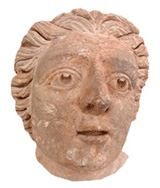 By
the 4th century BC the city had been renamed "Philadelphia"
after its Ptolemaic ruler, Philadelphus. Seleucid
and Nabataean rule followed until 63 BC, when
it was absorbed into the Roman Empire and the
Roman general, Pompey, annexed Syria and made
Philadelphia part of the Decapolis League - an
alliance of ten free city-states with overall
allegiance to Rome. The Romans rebuilt the city
with colonnaded streets, baths, a theatre and
impressive public buildings. Philadelphia found
itself at the centre of the new Roman province
of Arabia and of lucrative trade routes running
between the Mediterranean and an interior which
stretched to India and China as well as routes
north and south. The city flourished. By
the 4th century BC the city had been renamed "Philadelphia"
after its Ptolemaic ruler, Philadelphus. Seleucid
and Nabataean rule followed until 63 BC, when
it was absorbed into the Roman Empire and the
Roman general, Pompey, annexed Syria and made
Philadelphia part of the Decapolis League - an
alliance of ten free city-states with overall
allegiance to Rome. The Romans rebuilt the city
with colonnaded streets, baths, a theatre and
impressive public buildings. Philadelphia found
itself at the centre of the new Roman province
of Arabia and of lucrative trade routes running
between the Mediterranean and an interior which
stretched to India and China as well as routes
north and south. The city flourished.
During the Byzantine period, when Christianity
became the official religion of the Eastern Roman
Empire the city was the seat of a Christian Bishop
and two churches were constructed. By the early
7th century, Islam was already spreading northwards
from the Arabian Peninsula and, by 635AD, had
embraced the land as part of its domain. The city
returned to its original Semitic name of Ammon,
or as it is known today, Amman.
With various shifts in political power over the
following centuries, Amman's fortunes declined.
During the Crusades and under the Mamelukes of
Egypt, Amman's importance was overtaken by the
rise of Karak in the south. By 1321 AD, it was
reported that Amman was 'a very ancient town and
was ruined before the days of Islam' there are
great ruins here and the river al-Zarqa flows
through them."
Under the Ottoman Empire, Amman remained a small
backwater with Salt being the main town of the
area. By 1806 the city was reported to be uninhabited
except for the Bedouins.
Aqaba
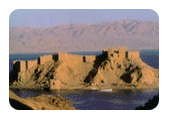 Aqaba's
long history dates back to pre-biblical times,
when it was known as Ayla. According to the Bible's
Old Testament, King Solomon built a navel base
at Ezion Geber, just 3 kilometers from where the
modern town of Aqaba stands today. Aqaba's
long history dates back to pre-biblical times,
when it was known as Ayla. According to the Bible's
Old Testament, King Solomon built a navel base
at Ezion Geber, just 3 kilometers from where the
modern town of Aqaba stands today.
From 106 AD, the Romans, who ruled the region
from their base in Sypria, also used Ayla as their
trading sea port, until it came under the control
of the Byzantine Empire in the early 4th century.
The Byzantines appointed Christian Arabs from
south Arabia to rule the port city on their behalf.
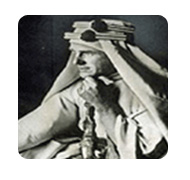 The
Middle Ages were turbulent years for Ayla. In
the 12th century, the crusaders captured the city.
They built a fort on Far'un island, known then
as Ile de Graye, 7 kilometers offshore Ayla was
then retaken by Saladin and the fort became known
as Saladin's Castle. In a counter-attack, the
notorious crusader, Reynald de Chatillon, took
the island, but lost it again to Muslim forces
the following year. The
Middle Ages were turbulent years for Ayla. In
the 12th century, the crusaders captured the city.
They built a fort on Far'un island, known then
as Ile de Graye, 7 kilometers offshore Ayla was
then retaken by Saladin and the fort became known
as Saladin's Castle. In a counter-attack, the
notorious crusader, Reynald de Chatillon, took
the island, but lost it again to Muslim forces
the following year.
When the Mameluk Sultans of Egypt took
control of the region, they renamed the city Aqaba
and, in the 14th century, built the town's famous
Mameluk fort. The Mameluks were followed by the
Ottomans, who ruled Aqaba for 4 centuries.
Aqaba was taken from the Ottomans, in 1917, by
Arab forces together with T.E. Lawrence. At the
end of the 1st World War, the British secured
Aqaba for Jordan.
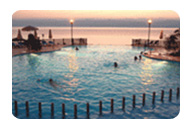 Dead
Sea Dead
Sea
The Jordan Valley is part of the Great Rift Valley
that runs from Turkey to east Africa, formed by
a series of geological upheavals millions of years
ago. The Dead Sea originally stretched the entire
360 kilometres, from Aqaba, in the south, to Lake
Tiberias (the Sea of Galilee) in the north.
The therapeutic water of the Dead Sea, combined
with the valley's fertile land and warm climate,
have attracted people to live, hunt and farm in
the area since the Stone Age. Over 200 archaeological
sites have been discovered, but there are believed
to be many more.
Many of the historical sites around the Dead
Sea region are intrinsically linked with biblical
events.
Jerash
Ancient Jerash was an open city of freestanding
structures richly embellished with marble and
granite. Its engineering was so advanced that
large parts of the city still survive today. Much
more has been painstakingly restored by archeological
teams from around the world.
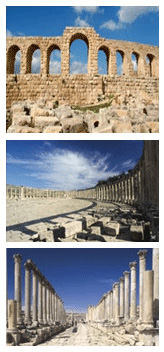 Hippodrome Hippodrome
This massive arena was 245m long and 52m wide
and could seat 15,000 spectators at a time for
chariot races and other sports. The exact date
of its construction is unclear but it is estimated
between the mid-second to third century AD. It
is now also possible to relive the days when gladiators
and charioteers appeared before the crowds, with
regular re-enactments by the Roman Army and Chariot
Experience (RACE).
Oval Plaza
The spacious plaza measures 90mx80m and is surrounded
by a broad sidewalk and colonnade of 1st century
AD Ionic columns. There are two alters in the
middle, and a fountain was added in the 7th Century
AD. This square structure now supports a central
column, which was recently erected to carry the
Jerash Festival Flame.
Colonnaded Street
Still paved with the original stones - the ruts
worn by chariots are still visible - the 800m
Cardo was the architectural spine and focal point
of Jerash. An underground sewage system ran the
full length of the Cardo and the regular holes
at the sides of the street drained rainwater into
the sewers.
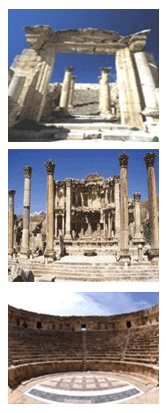 Cathedral Cathedral
Further up the Cardo Maximus, on the left is the
monumental and richly carved gateway of a 2nd
century Roman Temple of Dionysus. In the 4th century
the temple was rebuilt as a Byzantine church now
referred to as the 'Cathedral' (although there
is no evidence that it held more importance than
any of the other churches). At the top of the
stairs, against an outer East wall of the Cathedral
is the shrine of St. Mary, with a painted inscription
to Mary and the archangels Michael and Gabriel.
Nymphaeum
This ornamental fountain was constructed in 191AD
and dedicated to the Nymphs. Such fountains were
common in Roman cities, and provided a refreshing
focal point for the city. This well-preserved
example was originally embellished with marble
facings on the lower level and painted plaster
on the upper level, topped with a half-dome roof.
Water cascaded through seven carved lion's heads
into small basins on the sidewalk and overflowed
from there through drains and into the underground
sewage system.
North Theatre
The North Theatre was built in 165AD. In front
is a colonnaded plaza where a staircase led up
to the entrance. The theatre originally only had
14 rows of seats and was used for performances,
city council meetings, etc. In 235AD, the theatre
was doubled in size to its current capacity of
1,600. The theatre fell into disuse in the 5th
century and many of its stones were taken for
use in other buildings.
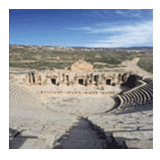 South
Theatre South
Theatre
Built during the reign of Emperor Domitian, between
90-92AD, the South Theatre can seat more than
3000 spectators. The first level of the ornate
stage, which was originally a two-storey structure,
has been reconstructed and is still used today.
The theatre's remarkable acoustics allow a speaker
at the centre of the orchestra floor to be heard
throughout the entire auditorium without raising
his voice. Two vaulted passages lead into the
orchestra, and four passages at the back of the
theatre give access to the upper rows of seats.
Some seats could be reserved and the Greek letters
which designate them can still be seen.
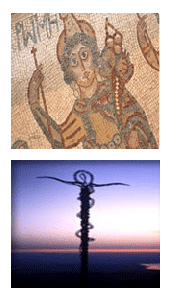 Madaba Madaba
Madaba is an ancient town of the Jordanian Plateau,
which was resettled by Christian Arab tribes from
the Karak region in 1880 A.D. It is now inhabited
by Christians and Muslims alike. A great deal
of antiquity has been found here, much of which
can now to be seen in the Museum and in Archaeological
Parks. The stunning 6th century Byzantine mosaic
map, which is located in the contemporary Greek
Orthodox church of St. George and shows Jerusalem
and other holy sites, features around two million
pieces of colored stone!
Ten minutes to the west of Madaba is the most
revered site in Jordan: Mount Nebo, with the memorial
of Moses at the presumed site of the prophet's
death and burial place.
|



